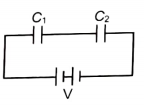In the circuit below and . If no capacitor can sustain more than 50 V, then the maximum potential difference between X and Y is:

1. 95 V
2. 75 V
3. 150 V
4. 65 V

In the circuit shown below and . If the charge on C1 is then potential difference between X and Y is
1. 2 V
2. 3 V
3. 6 V
4. 3.5 V
In the circuit below, if a dielectric is inserted into C2, then the charge on C1 will:

1. Increase
2. Decrease
3. Remains same
4. Be halved
A capacitor with plate separation d is charged to V volts. The battery is disconnected and a dielectric slab of thickness and dielectric constant '2' is inserted between the plates. The potential difference across its terminals becomes:
1. V
2. 2 V
3.
4.
An uncharged parallel plate capacitor having a dielectric of constant K is connected to a similar air-cored parallel capacitor charged to a potential V. The two capacitors share charges and the common potential is V'. The dielectric constant K is:
1.
2.
3.
4.
A battery does 200 J of work in charging a capacitor. The energy stored in the capacitor is:
1. 200 J
2. 100 J
3. 50 J
4. 400 J
Two identical capacitors are connected in parallel across a potential difference V. After they are fully charged, the positive plate of the first capacitor is connected to the negative plate of the second and the negative plate of the first is connected to the positive plate of the other. The loss of energy will be:
1.
2.
3.
4. Zero
The figure shows equipotential surfaces for a two charges system. At which of the labeled points will an electron have the highest potential energy?

1. Point \(A\)
2. Point \(B\)
3. Point \(C\)
4. Point \(D\)
A thin, metallic spherical shell contains a charge Q on it. A point charge q is placed at the centre of the shell and another charge q1 is placed outside it as shown in the figure. All the three charges are positive. The force on the central charge due to the shell is:
1. towards left
2. towards right
3. upward
4. zero
In the electric field of a point charge q, a certain charge is carried from point A to B, C, D, and E, the work done:
1. is least along the path AB
2. is least along the path AD
3. is zero along any one of the paths AB, AC and AE
4. is least along AE.









